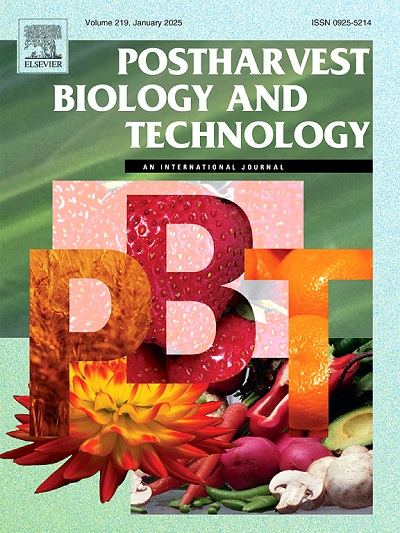Spermidine treatment delays postharvest senescence of prune (Prunus domestica L.) fruit by regulating reactive oxygen species and membrane lipid metabolism
IF 6.4
1区 农林科学
Q1 AGRONOMY
引用次数: 0
Abstract
Spermidine (Spd), a membrane stabilizer and free radical scavenger, plays a pivotal role in delaying post-harvest fruit senescence. Herein, prune fruit was treated with Spd to explore its impact on fruit quality, with D-arginine (D-arg), a polyamine inhibitor, utilized as a negative control. We focused on analyzing the regulatory effects of both treatments on reactive oxygen species (ROS) and membrane lipid metabolism in prune fruit. The results showed that Spd reduced respiration rate and weight loss while maintaining high levels of firmness, soluble solid content (SSC), and titratable acid (TA). Spd maintained elevated levels of ascorbic acid (AsA) and glutathione (GSH), enhanced ROS scavenging enzyme activities and antioxidant capacity, thereby mitigating ROS-induced oxidative damage to cell membranes. Moreover, Spd inhibited the activities of phospholipid-degrading enzymes while sustaining elevated fatty acid desaturase (FADS) activity. Thus, Spd increased the levels of phosphatidylcholine (PC), phosphatidylinositol (PI), unsaturated fatty acids (USFAs), unsaturated fatty acid index (IUFA), and the ratio of unsaturated fatty acids to saturated fatty acids (U/S). Concurrently, Spd inhibited the accumulation of oxidative stress products and saturated fatty acids (SFAs), mitigated the increase in cell membrane permeability (CMP), thereby sustaining the structural and morphological integrity of mitochondria and cellular membranes in prune fruit. In contrast, D-arg treatment yielded diametrically opposite results. These results indicate that Spd delays prune fruit senescence by regulating ROS and membrane lipid metabolism.
亚精胺处理通过调节活性氧和膜脂代谢延缓李子采后果实衰老
亚精胺(Spd)是一种膜稳定剂和自由基清除剂,在延缓果实采后衰老中起着关键作用。本研究用Spd处理西梅果实,以多胺抑制剂d -精氨酸(D-arg)作为阴性对照,探讨Spd对果实品质的影响。重点分析了两种处理对李子梅果实活性氧(ROS)和膜脂代谢的调控作用。结果表明,Spd降低了呼吸速率和体重损失,同时保持了较高的硬度、可溶性固形物含量(SSC)和可滴定酸(TA)水平。Spd维持抗坏血酸(AsA)和谷胱甘肽(GSH)水平升高,增强活性氧清除酶活性和抗氧化能力,从而减轻活性氧引起的细胞膜氧化损伤。此外,Spd抑制了磷脂降解酶的活性,同时维持了脂肪酸去饱和酶(FADS)活性的升高。因此,Spd增加了磷脂酰胆碱(PC)、磷脂酰肌醇(PI)、不饱和脂肪酸(USFAs)水平、不饱和脂肪酸指数(IUFA)和不饱和脂肪酸与饱和脂肪酸之比(U/S)。同时,Spd抑制了氧化应激产物和饱和脂肪酸(sfa)的积累,减轻了细胞膜通透性(CMP)的增加,从而维持了李子果实线粒体和细胞膜的结构和形态完整性。相反,D-arg处理产生了完全相反的结果。这些结果表明,Spd通过调节ROS和膜脂代谢来延缓李子果实衰老。
本文章由计算机程序翻译,如有差异,请以英文原文为准。
求助全文
约1分钟内获得全文
求助全文
来源期刊

Postharvest Biology and Technology
农林科学-农艺学
CiteScore
12.00
自引率
11.40%
发文量
309
审稿时长
38 days
期刊介绍:
The journal is devoted exclusively to the publication of original papers, review articles and frontiers articles on biological and technological postharvest research. This includes the areas of postharvest storage, treatments and underpinning mechanisms, quality evaluation, packaging, handling and distribution of fresh horticultural crops including fruit, vegetables, flowers and nuts, but excluding grains, seeds and forages.
Papers reporting novel insights from fundamental and interdisciplinary research will be particularly encouraged. These disciplines include systems biology, bioinformatics, entomology, plant physiology, plant pathology, (bio)chemistry, engineering, modelling, and technologies for nondestructive testing.
Manuscripts on fresh food crops that will be further processed after postharvest storage, or on food processes beyond refrigeration, packaging and minimal processing will not be considered.
 求助内容:
求助内容: 应助结果提醒方式:
应助结果提醒方式:


